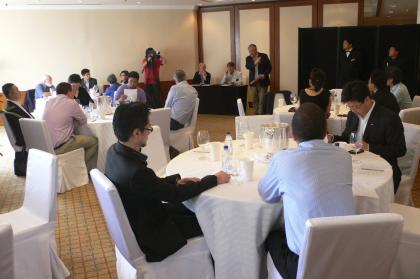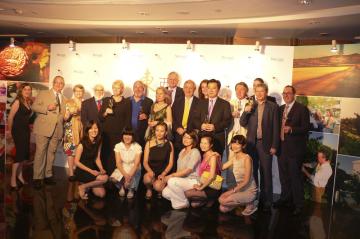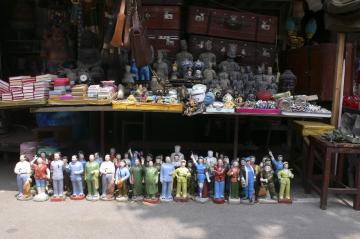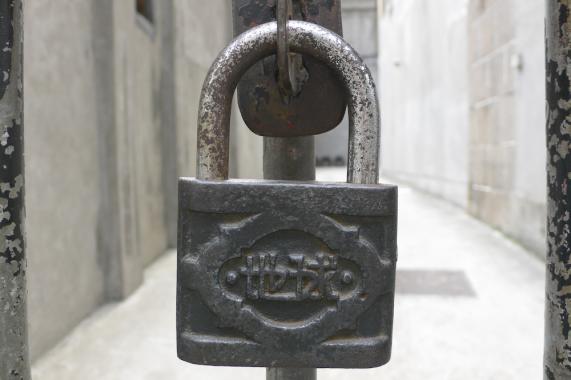The China Wine Challenge
POSTED ON 15/08/2011In the first part of this blog post, Ron Brown talked about the Japan wine market and setting up the Japan Wine Challenge. This week, he discusses the China Wine market and the China Wine Challenge's place in it.
 Feet up in Shanghai
Feet up in Shanghai
Why and how did you decide to set up the China Wine Challenge?
I have had three incarnations in wine in China. The first was from 1984 to 1988 when I ran Moët Hennessy and Jardine’s wines and spirits joint venture in Hong Kong and China . The market was in its infancy and we dealt exclusively with the monopolies, which were of course state-owned and run. All our stock in the duty-paid market was sold on a consignment basis because we had no choice, and it really was a desperate way to do business. The monopoly for the duty-free business was an easier prospect, but basically the China market was extremely difficult. You could only buy imported wine with foreign exchange coupons because otherwise you couldn’t recoup your money internationally and so that in turn meant that imported wines and spirits products, indeed any imported product, was only available to those who had foreign exchange coupons, which was a very select group.
I then came back to China setting up our businesses in the very late 1990s and it was clear that it had changed or was in the course of evolution. Then I started doing business in China with my own brand Maverick. We work with one of the leading wine importers in China, Mercuris. I started coming to China quite a lot and saw at first hand a very real evolution, and I saw that here was a huge need for wine education. The Chinese are very quick, they’re very thirsty (excuse the pun) for knowledge and David Wrigley [of the WSET] told me China is now one of their top five export markets, as it were, outside UK, which doesn’t surprise me. In the China Wine Challenge we had no less than four Diploma Level 4 people judge and the leading players are set to get their credentials through the WSET and move on where possible to the Master of Wine or Master Sommelier or to MBAs for wine, and so it’s all happening.
 Under Starter's Orders at the CWC
Under Starter's Orders at the CWC
And so I decided I would ask my partners in the Japan Wine Challenge if they wished to add some days to their sojourn in Japan to which they all unanimously said yes and so began the China Wine challenge. The main difference between China and Japan is that in China, there are still very strict rules on importing sample wines. It is possible to import samples. For instance we asked for three samples for our competition, but that effectively means you need six as customs take three samples. For small producers that adds exponentially to the cost as they also have to airfreight them as it’s the only way to put it in and the paperwork is immense and so the entry cost is very high, but we do make that option available, and I think 30 wineries from around the world took us up on it, and so although it was very expensive to go that route, they felt it was worth it to get their wines in and exposed to the importers.
Although we work closely with the importers in Japan , and we also work very closely with 5000 or so wineries around the world, in China we really work with the importers because it’s so tough for a winery to submit wines. So that means we work, I would say, very well with the top 20 wine importers in China. They then work in turn with their suppliers, and tend to choose wines that are already in the marketplace, or, ship them out with another shipment; so that’s the big difference in terms of structure of the competition. Otherwise we have the same elements are in place.
We have the Institute of Masters of Wine and the WSET workshop, which is very popular. We have inaugurated this year with the support of the Madame Bollinger Foundation, the Madame Bollinger Foundation award and scholarship for the best Chinese judge, to go to the summer school in Australia with the Institute of Masters of Wine, something we have been doing in Japan for the last 10 years; and that covers all the costs of accommodation, tuition and air fare. We found in China this year, and in Japan over the last 10 years, that that’s really encouraged (a) the top wine palates in China and Japan to come as judges and (b) for them to take the examination, which is a written test, and I think that has really created a fantastic incentive for people in China and Japan to broaden their palate and reach for the stars.
 Home and Away
Home and Away
How do you see the Chinese market evolving and how different is it [from Japan]?
I’ve had a good chance to meet with a lot of importers over the last couple of years. So although I had been out of the market in wines and spirits between 1988 until three or four years ago, I’d like to think I’ve gleaned quite a lot of what’s going on. In China there are three main geographical markets. There’s the market around Shanghai. There’s the market to the north with Beijing, and the market to the south, not just Guangzhou but other huge cities as well. So there are three quite clear geographical markets and you could also throw in the west around Szechuan.
Taking these three main markets, the market to the north is probably the most difficult, probably the least developed, and where people are willing to spend the least money. Having said that, I go to Beijing at least twice a year, and compared to 30 years ago, it’s absolutely a miracle what’s happened there, so everything’s relative. Shanghai is the most obvious market with the highest density of 5- star hotels, some wonderful restaurants and fantastic on-premise business for top wines and one or two leading wine chains now specialising in premium wines off-premise. So Shanghai as a city just has to be the number one wine city. However in the south, it’s full of business people, who love to drink, to gamble, to have fun and make a noise and they love to buy things and so that’s probably the best wine market, writ large. I’ve been all over South China and every time I go to a distributor’s evening, it’s always the same. A distributor has a fine wine fine shop with all sorts of terrific wines, he invites 50 of his friends, customers, whatever, they all drink copious amounts of wine, they’re singing away, and they drink, and they buy copious amounts of wine.
 Ladies and Gentlemen, Your Lobster Tail is Served
Ladies and Gentlemen, Your Lobster Tail is Served
So actually the South China market today is the one which has the most volume going for it, while Shanghai is the most sophisticated and modern, and Beijing solid. So that’s the geographical split. The actual wine split basically divides between very expensive brands of which the most popular are of course the Bordeaux grands crus classés and then at the bottom it’s price. The one word that’s common to both is price. Chinese consumers buy on price. They buy expensively priced, they buy less expensively priced. The general consensus among importers is that in China consumers don’t yet have a sufficiently developed concept of value to be able to equate price to value. So tits’ very safe to buy a Château Mouton-Rothschild 1982, everybody in the world knows it’s a fine wine. And it’s very safe to buy Two Buck Charlie (at an FOB of $2 just as in Japan), because if you choose a bad wine, well, it doesn’t really matter. So that’s where China is today and so the need for a China Wine Challenge is acute.
One of our greatest challenges in China is how to get the message across and that’s why we work very intensely with the leading media, and not just the English-language media. We really want to get the word out that in a very confused market where people genuinely don’t really know how to buy wine between 200 and 1500 Renminbi retail (£20 and £150), we believe can give them the confidence and the opportunity. And it’s going to be a bit of a process but the Chinese are very quick learners. So if you ask what is my hope for the next five to 10 years, it is that the Chinese wine consumer will understand the real value of what lies in the middle where you do need some knowledge. The China Wine Challenge awards can help and the more formal system of education provided by the WSET and their providers, by the Institute of Masters of Wine, by sommeliers and by the importers themselves and the media; the cumulative effect will hopefully help China develop into a more nature wine market.
 The Judges
The Judges
 The People
The People
To what extent is the 48% tax on wine an inhibiting factor?
At the end of the day tax is tax, and whatever the tax rate is it adds an additional entry level barrier to the wine. But I’m a defender of the China tax system, because if you put it against Asia overall, it’s actually quite benign. Thailand and India lead the charge with roughly 400% tax and duty. You could argue then that they are prohibitive, but Thailand actually is a very good market because so many foreigners go there who are willing to pay the price. Hong Kong of course for a couple of years has had zero duty and tax, so these are the parameters. And we must remember that in Japan until not so long ago, the upper wines paid if I remember correctly 21.3% in duty in addition to tax, so if you take an expensive wine, that’s quite a hike. Now the average bottle pays I think 180 Yen in duty and tax, which is roughly roughly $2 a bottle. So I think that China will probably come under some sort of pressure to adopt a flat tax rate rather than an ad valorem tax rate. Tax and duty are instruments of government policy but certainly in other markets it’s been proven that when you reduce tax and duty, and exponentially increase sales, government revenue also can increase. Having said that, 48% tax in China is really not the end of the world and I think what it means is that you see some pretty decent wines in China. But still price is the dominating purchase consideration and therefore tax obviously exacerbates that.
Is the fact that the vast majority of wine in China is Chinese-produced and can be blended with wine from overseas an inhibiting factor?
The fact is that you actually drink what you’re exposed to. In Japan for instance, the Japanese consumer was for years very happy with Akadama (a sweet port-like Japanese-produced wine) and I’m sure if you asked any Japanese wine consumer today if they were happy to taste Akadama, they’d say no and I’m sure none of them will confess to ever having drunk it. The China wine consumer needs to be exposed to what are high quality wines. When I came to China we investigated a joint venture with a Chinese winery and we turned it down in the end because they were charging us a huge increment for exporting the wine but much more importantly the quality of the wine was terrible. It was oxidised, it was polyphenolic, it was disgusting.
 Tuna at the Shanghai Hilton
Tuna at the Shanghai Hilton
Over last few years we’ve seen a marked evolution in the quality of Chinese wine and the major part of that is due to investment. To have a successful wine does require having the right things in the winery and so China has the money to do that and the foreign companies have been major players. I think LVMH have just bottled the first Chandon wine or whatever its going to be called, so all people in all these serious companies can only be doing what they’re doing in the expectation that the market is going to be there. You’ve tasted the Torres wines and the Pernod-Ricard wines and the wines are good, even very good. So the reality is that there are Chinese wines out there and major top firms worldwide have invested, so they have to believe in this market, then market forces will take over, so let’s just assume that that market for quality China wine is going to grow, the quality of Chinese wine will grow and the China consumer will trade up.
One point I would like to make is that ever since I started doing business in China, people talk about 1.4 billion plus consumers. Now I think this is total rubbish. There are not 1.4 billion consumers for wine in China and there never will be. I asked several importers of the importers what the figures were, and as far as I can see China doesn’t really have the infrastructure, and it’s also just too damned big, so no-one really seems to know how many people in China are currently drinking imported wine. Certainly I remember from my old days in China when there was no capitalist system, no costing structure, it was 1 Renminbi for a bottle of wine, arbitrarily chosen, so that meant that everyone in China could drink wine and probably did. So I’ve got a feeling that there are probably huge numbers of people in China who are drinking but that’s not relevant to us.
The question is how many are there who are drinking imported wine or wines of quality from domestic wineries or who can be persuaded to move to those categories? My guess is that if there are 3 million people in China drinking imported wine and who knows, there could be one million, there could be five million, but not much more than 5 million, I suspect, there’s no reason in the world why that number shouldn’t go to 50 million in 5 – 10 years’ time, because there are enough middle-class rich Chinese consumers to buy that amount of wine. And that makes China a very major market, because if you take a market like the UK, you could argue that you have the making of a market that’s two and half times the size of the UK market. And I imagine that’s why these companies are so interested. I’ve been involved with Asia for 35 years and I’ve seen changes in Asia that you can only guess at, so I’m extremely positive about the evolution of the wine consumer, and indeed wine drinking, wine as part of your life, part of the mood, part of the food, but it’s not going to happen by itself and it’s going to need a concerted joint effort by all stakeholders, be they wineries, importers, educators, sommeliers and media, to make this happen.
 Anyone Got the Key to Unlocking the Market?
Anyone Got the Key to Unlocking the Market?

